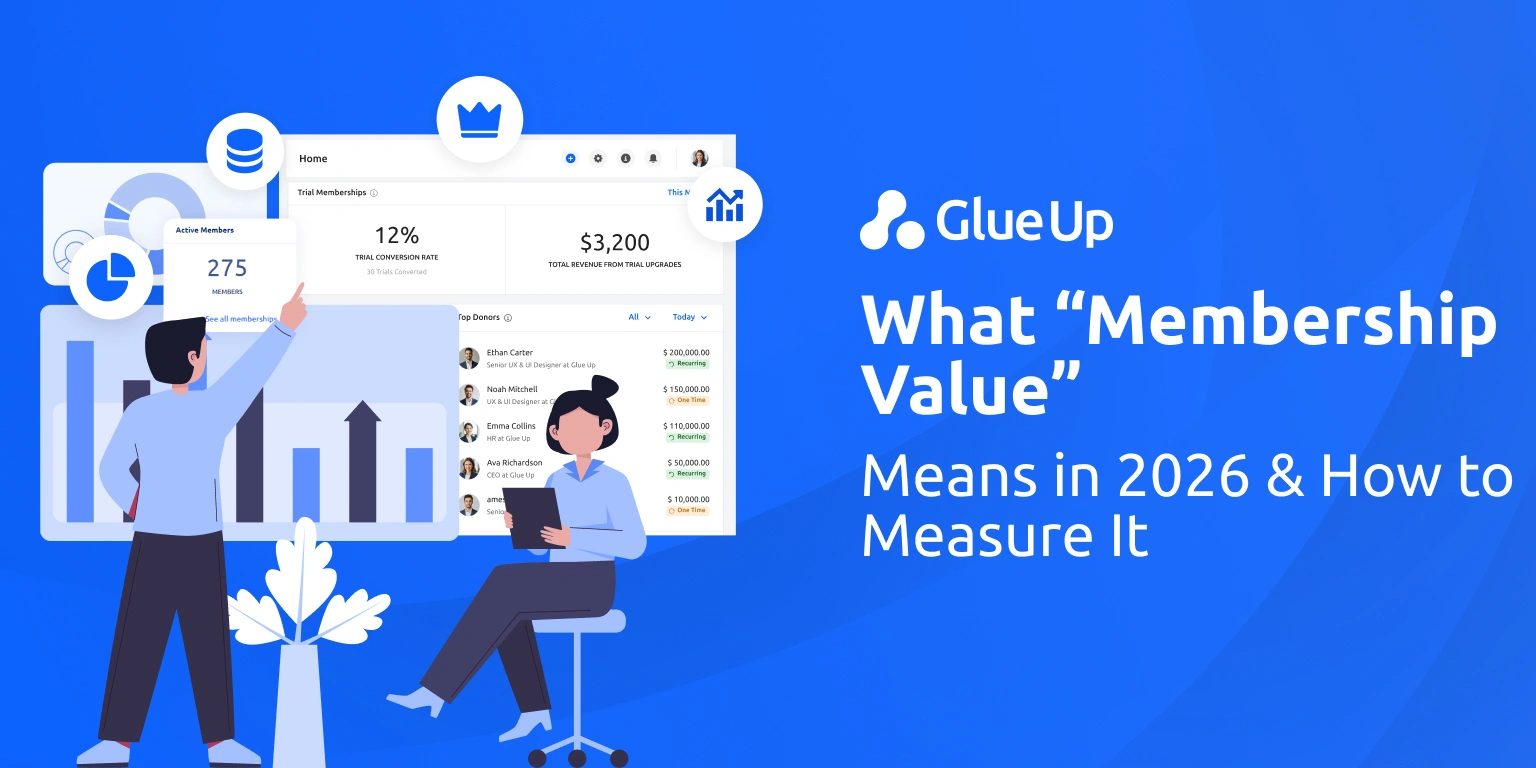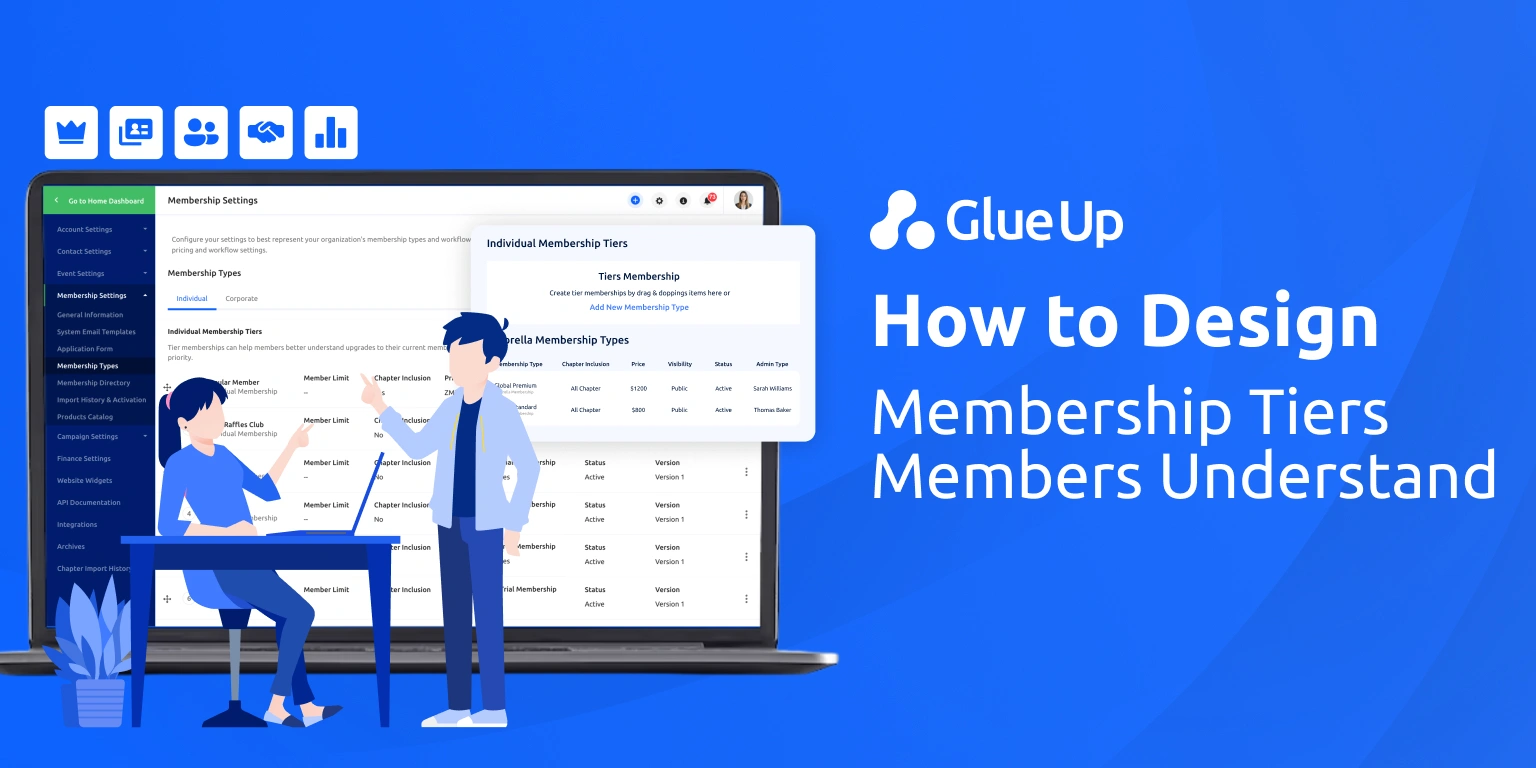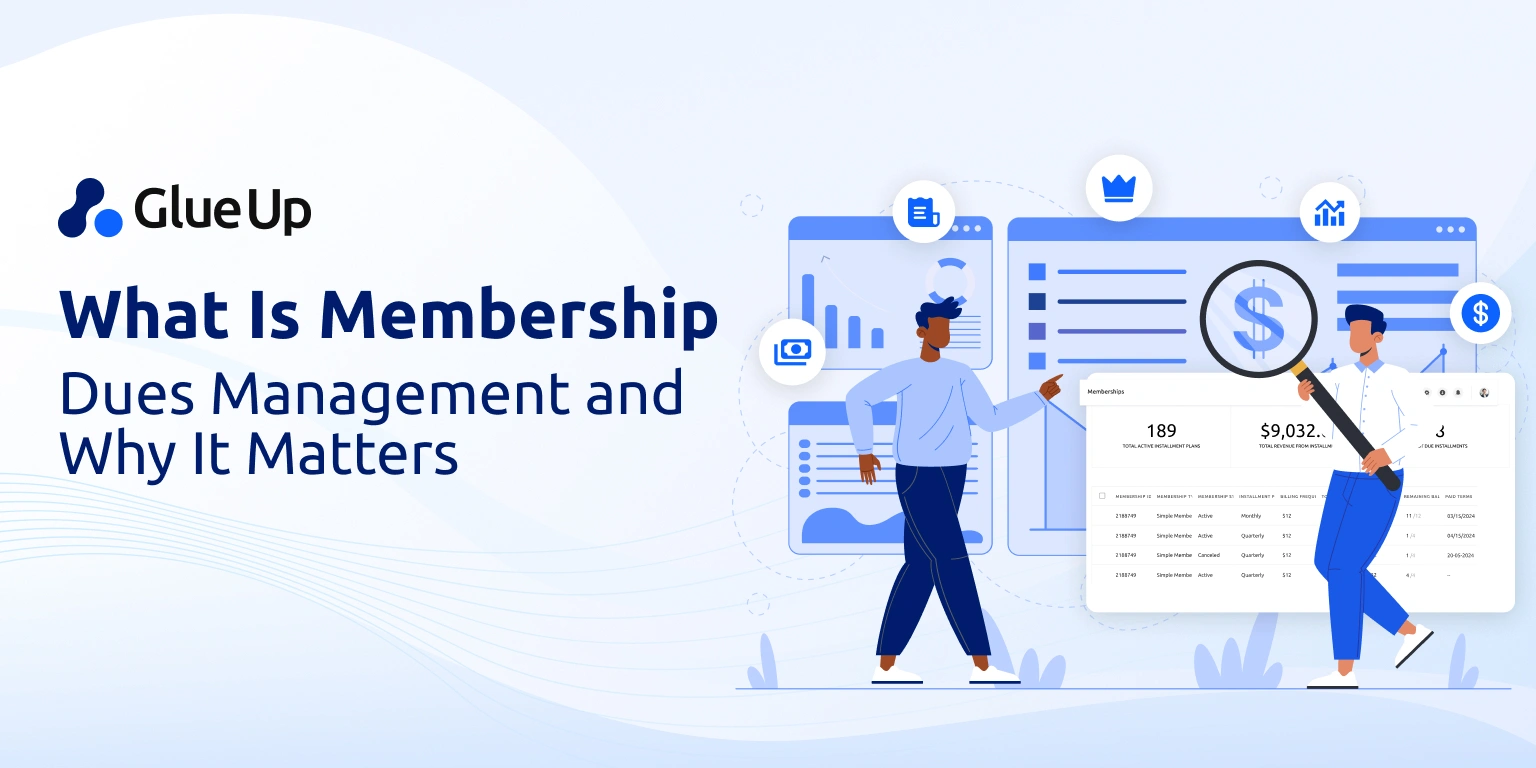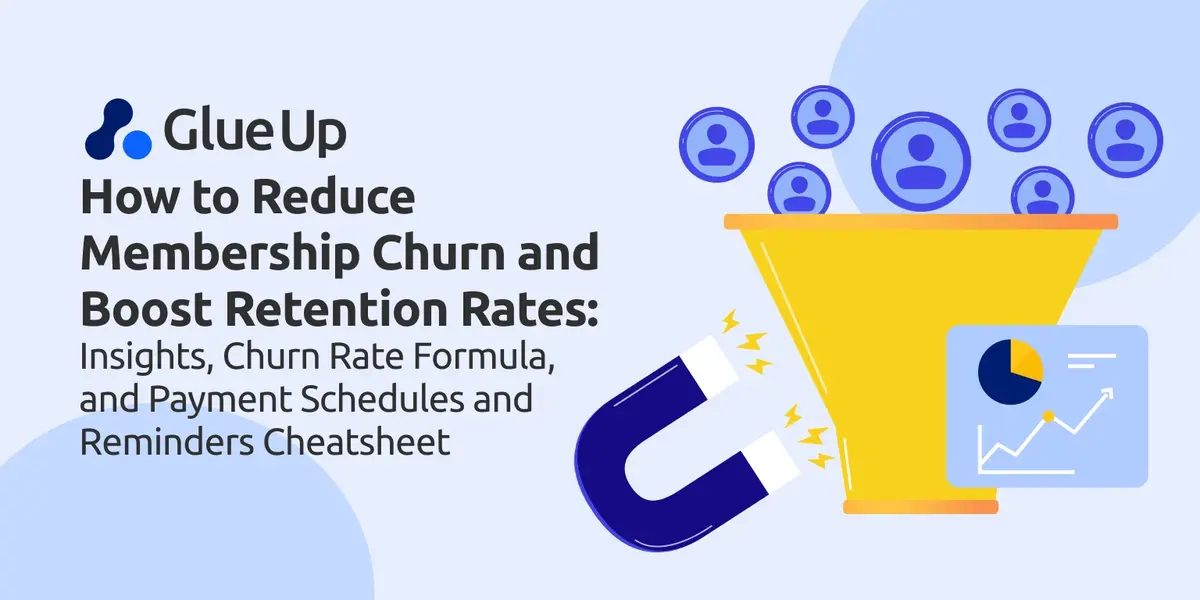
We know you might be concerned about your membership churn rate or your retention plan failing to produce positive results in the industry. This problem rears its ugly head more often than people would like.
The membership model is the cornerstone of most business models now and it has gained immense popularity among small businesses due to its flexibility, ease of implementation, and scalability.
However, it's essential to not just set up your membership program and sleep on it but also ensure it’s working effectively for your business. This way, you can take full advantage of its benefits like increased revenue, higher retention rates, and more returning customers
This article will provide you with best practices on how to reduce churn and increase retention rates. Now, without further ado, let’s get into it!
Key Takeaways
- Understand why churn is happening by analyzing common reasons members leave, such as lack of perceived value, high costs, low engagement, career changes, poor leadership, and not taking advantage of benefits.
- Improve the onboarding experience to engage new members right from the start. Provide a solid onboarding sequence, pre-qualify leads, and make yourself available to assist members.
- Offer alternatives to canceling, such as allowing members to pause their membership, providing discounts, or offering different membership tiers to fit their needs and budget.
- Engage existing members through targeted email marketing, social media outreach, special offers, and soliciting their feedback. Regularly communicate the value and benefits of membership.
- Focus on providing an excellent member experience by constantly reviewing and improving your offerings, content, and customer service. Prioritize human interaction, build long-term relationships, and show members you value them.
What is Membership Churn? Definition & Calculation
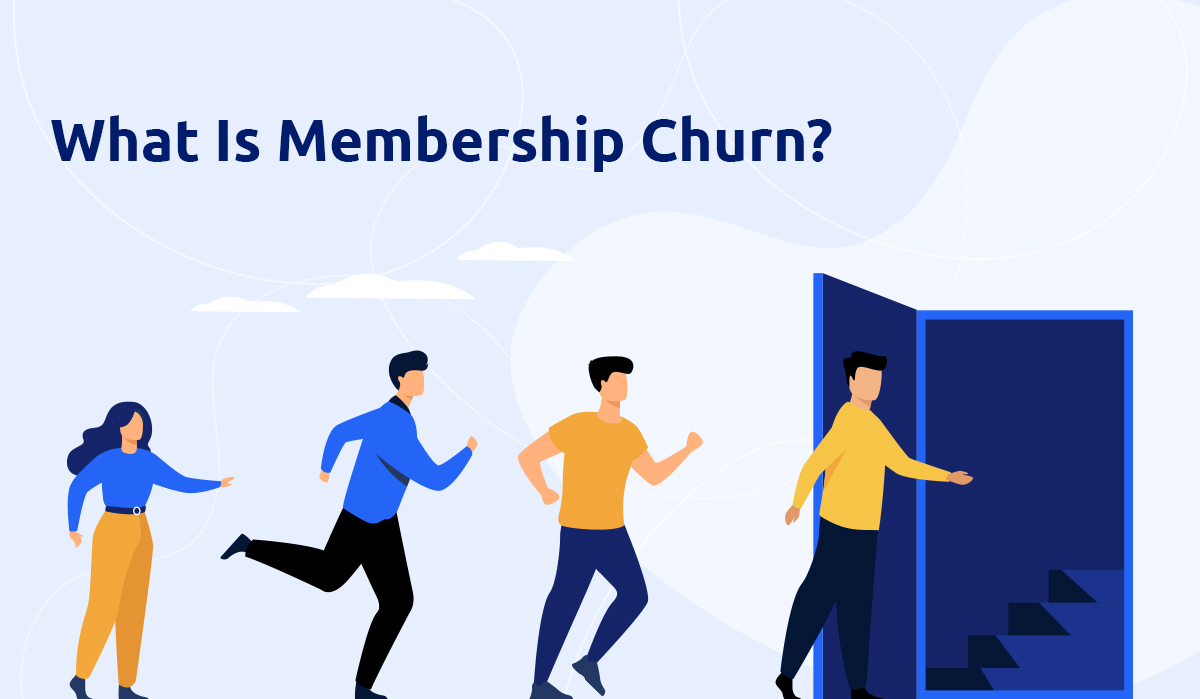
It is the rate at which members leave your membership program or the number of people who cancel their membership divided by the total number of members. The lower your churn rate, the better you retain members and keep them engaged with your brand.
How to Calculate Churn Rate?

The churn rate is the percentage of members who cancel their membership in a given period. It can be calculated for a single month, quarter, or year.
Churn Rate Formula
To calculate your membership churn rate, divide the number of members who left in a period by the total number of members at the end. For example, if you have 100 members today and lose 20 over one month:
- The first step is determining how many people are with you that month by subtracting your current membership from 100 (100-20=80).
- Then, divide this number by 80 to get an idea of how many people left your organization during that month (15/80=0.19).
MRR Churn
It is the value of MRR lost due to churn. To calculate your MRR (Monthly Recurring Revenue) churn and MRR churn rate, follow these steps:
- Determine the value of MRR lost due to churn: MRR Churn = Total MRR value of customers who churned in a given period
- For example, if you lost two customers in a month, one with an MRR of $100 and another with an MRR of $150, your MRR Churn would be: MRR Churn = $100 + $150 = $250
MRR Churn Rate
It is the percentage of MRR lost due to churn. You can calculate your MRR Churn Rate by dividing the MRR Churn by the total MRR at the beginning of the period:
- MRR Churn Rate = (MRR Churn / Total MRR at the beginning of the period) × 100%
- For instance, if your total MRR at the beginning of the month was $10,000 and your MRR Churn was $250, your MRR Churn Rate would be: MRR Churn Rate = ($250 / $10,000) × 100% = 2.5%
In this example, an MRR Churn Rate of 2.5% means that you lost 2.5% of your monthly recurring revenue due to customer churn in that given period.
Figure Out Why Churn is Happening

The second step to reducing churn is figuring out why it's happening. Here are a few examples of the type of causes you'll want to look into:
- The onboarding phase wasn't engaging enough or didn't include enough information (for example, the pricing information)
- Members had problems with their membership experience (for example, they weren't sure how to get in touch with customer service)
- Members didn’t have clear instructions on how they could use your product or service (for example, they didn't know how they were supposed to use your webinar software, or which features worked best)
Once you've determined what caused your members' churn, you'll be able to take actionable steps toward improving recruitment and membership retention rates.
For example: If many members left because they felt that the onboarding process was too long and repetitive, try breaking up the cycle into multiple steps so that it doesn't feel quite as overwhelming at once. If member churn occurred because of concerns about payment methods and billing procedures—maybe there's a better way for them to handle these issues than having them call an 800 number?
Most Common Reasons Why Members Leave
Members often leave organizations for various reasons. Here are five common ones backed by statistics and expert insights:
Lack of Value
Nearly 40% of members leave because they don't perceive enough value in their membership.
This issue often arises when members feel that the benefits they receive do not justify the cost of membership.
To address this, you need to ensure they clearly communicate the value and benefits of membership, such as professional development, networking opportunities, and exclusive resources (Sidecar AI) (Higher Logic).
High Cost
The cost of membership is a significant factor, with many members leaving due to financial constraints.
This can be due to personal financial issues or employers no longer covering the membership fees. Offering flexible payment options, such as monthly dues or discounts for returning members, can help mitigate this issue
Lack of Engagement
Members who do not feel engaged with the organization are likely to leave.
Approximately 24% of associations do not have a tactical plan to increase member engagement. Strategies to boost engagement include creating opportunities for members to connect digitally, organizing events, and maintaining regular, personalized communication. (Markens Group).
Career Changes or Retirement
Members often leave associations when they change careers or retire. While career changes are largely beyond your control, offering benefits tailored to retirees, such as discounted memberships or volunteer opportunities, can help retain this demographic.
Poor Leadership and Organizational Direction
Inconsistent leadership and a lack of clear direction can lead to member dissatisfaction.
Thus, you need to ensure that your leadership is actively engaging with members, setting clear goals, and providing a strategic direction that aligns with member needs and expectations.
Low Engagement
Low engagement can be another factor adding to an increased churn rate. It is a measure of how a member interacts with your site. For instance, If you have an e-commerce site, it could be the number of products purchased or searched through. Engagement could be the number of videos watched or articles read for an entertainment website.
You can calculate this engagement by dividing the number of activities by the total members or visits. To involve your members more effectively, you need to have some solid member engagement ideas.
You can do it by making your website more engaging for visitors if you provide more valuable content (and opportunities to purchase from). Another option would be to offer discounts and special offers to increase sales and create urgency in customers’ minds, making them more likely to complete whatever action they were considering before leaving.
Missing or Late Dues
Sometimes, it’s as simple as that. Members may simply not be paying their dues on time because they don’t see value in the community—or they may merely be forgetful.
Use this opportunity to communicate the value of membership and how it helps you accomplish your organization's mission. You want people who are passionate about what you do, not just those who need an outlet for their free time or want a discount on services (though those types of memberships can still work).
Diminishing Contributions
A contributing member is a “good” member and will likely stay with your organization for a long time. However, if you don’t encourage them to contribute, they may not be contributing. It is particularly true if other members of the organization aren’t encouraging them.
A good way to keep members involved and engaged in the organization is through fundraising campaigns that allow them to give back in some way.
Not Taking Advantage of Membership Benefits
Membership benefits, like rewards and discounts, are a great way to keep your members engaged. They also help you stand out from competitors by offering something no one else does. Using these benefits will increase your retention rates.
Here’s what you need to do:
- Explain the benefit clearly and concisely on your website or mobile app. You want members to understand how it works and how they can use it to get the most value out of it.
- Make access easy—don’t make them jump through hoops just to get their discount or reward coupon code!
- Make sure that whatever benefits you offer are relevant to your target audience—you don't want them wasting their time with irrelevant offers or coupons (and neither do they).
Types of Membership Churn
Understanding the various types of membership churn is crucial to developing effective strategies to reduce it and boost your retention rates.
Let's take a deeper look at each type of churn and explore how you can tackle them head-on.
Voluntary Churn
Voluntary churn happens when a member actively chooses to leave your association.
This can be due to a variety of reasons, such as a lack of perceived value, changing professional needs, or a mismatch between their expectations and your offerings.
To minimize voluntary churn, you must focus on consistently delivering value to your members. Regularly communicate the benefits of membership, showcase success stories, and provide exclusive resources and opportunities.
It is also advisable to engage with your members through surveys, focus groups, and one-on-one conversations to gain insights into their needs, preferences, and pain points.
Use this feedback to tailor your offerings and ensure that you're meeting their evolving requirements.
Involuntary Churn
Involuntary attrition rate (failed payments) is the percentage of members who cannot make their membership payments due to billing failures or being declined.
There are a number of things that can cause it, so keep an eye on it. Your involuntary churn rate will vary depending on your industry, but as a general rule:
- Membership payments - watch for this type of involuntary churn if you're operating in the service industry (e.g., gym, yoga studio, etc.) since these types of businesses usually work on monthly membership plans where people will pay for their services at the beginning of each month.
- Membership cancellations - look out for this type if you're operating in an industry that requires a lot more flexibility from customers (e.g., cloud storage). These industries have higher cancellation rates than others due to changing needs/desires from customers over time or compatibility issues between products/services offered by other companies. It may require switching gears entirely when switching providers; consider offering annual plans instead so users don't have to worry about paying every month!
- Membership expirations - keep tabs on how many expire each month because it'll help determine whether or not there are any opportunities to increase lifetime value among existing customers through cross-sells/upsells based on those who haven't been using their accounts yet.
Active Churn
Active churn is similar to voluntary churn, where members actively decide to cancel their membership. However, it specifically refers to members who have found a better alternative or no longer see the value in their membership.
The best way to avoid active churn is to continuously innovate and improve your offerings. Stay ahead of industry trends and competitor offerings to ensure that your association remains the go-to resource for your members.
Demonstrate the unique value that your association provides and how it sets you apart from other organizations in your space.
Passive Churn
Passive churn happens when a member's membership lapses due to inaction, such as forgetting to renew or not updating their payment information.
To minimize passive churn, you should implement a robust renewal communication strategy. Send automated renewal reminders well in advance of the membership expiration date and follow up with personalized outreach to members who haven't renewed.
Offer incentives for early renewals, such as discounts or bonus resources, to encourage members to take action. Simplify the renewal process by offering online renewal options and pre-populated renewal forms.
Also, consider implementing auto-renewal programs for members who opt-in, ensuring a seamless renewal experience.
Gross Churn
Gross churn encompasses the total number of members who leave your association within a specific time frame, regardless of the reason. It includes both voluntary and involuntary churn.
Gross churn can be reduced by focusing on overall member satisfaction and engagement.
- Make sure to regularly assess your member engagement levels through surveys, event attendance, and online community participation.
- Identify areas where you can improve the member experience and implement strategies to boost engagement. This can include personalized content recommendations, targeted networking opportunities, and exclusive member benefits.
Maintaining a happy and engaged membership can reduce the likelihood of your association losing members.
Net Churn
Net churn takes into account the number of new members acquired during the same period as the gross churn, providing a more comprehensive view of your association's overall membership growth or decline.
To improve net churn, you need to focus on both reducing gross churn and implementing effective member acquisition strategies.
Develop targeted marketing campaigns to attract new members who align with your association's mission and values.
Leverage social media, content marketing, and referral programs to reach potential members and showcase the value of joining your association.
Lastly, offer compelling onboarding experiences to help new members quickly integrate into your community and start realizing the benefits of membership.
Contractual Churn
Contractual churn refers to the loss of members who have a fixed-term membership contract and choose not to renew upon expiration.
To combat contractual churn, you must engage with members throughout their membership term and demonstrate the ongoing value of membership.
Here are some additional strategies to reduce this type of churn:
- Regularly communicate the benefits they've received and the impact your association has had on their professional growth.
- Offer exclusive resources, events, and networking opportunities that are only available to members.
- As the contract expiration date approaches, provide compelling reasons to renew, such as new initiatives, expanded offerings, or special member discounts.
- Personalize your renewal communications to highlight the specific benefits and achievements each member has experienced during their membership term.
Noncontractual Churn
Noncontractual churn happens when members who don't have a fixed-term contract, such as those with month-to-month or open-ended memberships, discontinue their membership.
The best way to reduce noncontractual churn is to implement a fixed-term contract with them. However, if you wish to keep it flexible, you must consistently provide value and foster a strong sense of community.
- Engage with these members regularly through personalized communications, exclusive events, and online forums.
- Encourage them to participate in your association's activities and volunteer opportunities to deepen their connection with your organization.
- Recognize and celebrate their contributions and milestones to make them feel valued and appreciated.
The more relationships you build and the sense of belonging you create, the more likely it is that these members will remain with your association in the long run.
Best Tactics to Reduce Membership Churn
Reduce churn by adding just these few simple tweaks to your strategy:

- Having solid member onboarding experience.
- Providing alternatives to canceling.
- Being accessible to your members.
- Bring existing members back to your site through email marketing and social media or with discounts and special offers that require them to log in or renew their membership.
- Reach out to potential leavers with automated emails asking why they are considering leaving and then giving them an option for how they can stay a member. It can be done using exit-intent popups or simply asking in an email as part of the overall welcome email series you send out when someone joins your community/network/club etc., but don’t forget the importance of personal touch!
Want to learn more? Here we go.
Have a Solid Member Onboarding Sequence
A robust member onboarding sequence is essential to your community's lifecycle. It is the process of introducing new members to your community and making it personalized based on their interests.
The first email you send them should be a gentle introduction to the community, not a sales pitch. Make it clear that they are welcome here while also informing them how to get involved if they want to be more active in the community and how they can help others with their expertise when needed (as long as it’s appropriate).

With Glue Up's robust and easy-to-use email marketing software, you can do just that. It helps you build branded email campaigns, newsletters, and invitations for events that you can send in just a few minutes.
Pre-frame Your Offerings and Pre-qualify Your Leads
If you’re using a membership model, you must understand the types of members who are most likely to convert into paying clients. Before you even start marketing your product/service, make sure that you have a clear idea of what type of members you want to attract. You need to know what your target market looks like so that you can create offers that will appeal to them.
Once you’ve identified your ideal member, it makes sense to pre-qualify leads before they take their first step with you. By pre-screening leads, you can make sure that they are the right ones qualified for membership. By avoiding people who are not interested in your product or service at all, you can save time and money.
Provide Alternatives to Canceling
- One of the keyways to reduce member churn is by providing some alternatives to canceling. There are many ways to go about doing this. One way is that you can provide your customers with a way to get in contact with you and speak with someone about their problems and fears about canceling your service. This will allow them to feel like they have an alternative. They might not want to do this at first, but if they feel like they have nowhere else to turn, then it could be beneficial for them.
- You can just keep the lines of communication open by creating a help section on your website. This allows people to see all the possible solutions that you are trying to provide for them if they are facing an issue about being able to cancel your service. These alternatives will give them more options and help curb member churn in the process.
- If someone still wants to cancel their membership, ask what else you can do for them instead and create a solution that works for both parties. It may include offering another product or service that meets their needs in exchange for keeping the membership active for another month or two. You may also be able to offer lower pricing on additional products/services and waive cancellation fees if they continue with the same level of membership during this period.
Make Yourself Available to Your Members
Ensuring that your members are taken care of is vital for many reasons. First, it will help you retain them and keep them from leaving. Having a way for them to contact you anytime can also reduce voluntary churn because they won't feel alone in their struggle with whatever issue they're having.
Finally, being accessible to your members will help with the growth rate because they'll be more likely to recommend your business to others when they feel you treat them right.
Bring Existing Members Back
Once you get your existing members to engage with your site, there are many ways to keep them returning.
- Send an email newsletter that highlights the benefits of membership and gives an update on recent or upcoming events.
- Send a survey to see what members think about the organization, its programs, and its staff.
- Ask for feedback about how the organization is doing and what it can do better. For example: “What did you like about our last event?” or “How was working with [name] at [company name]?” In addition to gathering good data on member satisfaction levels (which should be shared with staff as well), this information can be used by leaders to make adjustments to improve their services over time—so they don't lose their members because they're not providing what people want!
Reach Out to Potential Leavers
- Reach out to members who haven't renewed directly or through an automated email campaign.
- Reach out to members who haven't logged in. You can send a welcome message after they've signed up, but it's also helpful to reach out again later and make sure they're still using the service and engaged with your community.
- Reach out to members who haven't posted in the forum. If someone hasn't posted on the forum, send them an email asking why they haven't been contributing as much as they used to. If there's nothing wrong with their account or payment information, ask if there's anything else you can do for them so that they'll return as active members of your community (make sure you phrase it positively).
- Reach out when people update their profile information or payment method information—they may want some help understanding how these features work!
Constantly Review User Experience
User experience is the sum of all interactions a person has with a product and this is what makes people stay or leave. In other words, it’s how you make them feel about you with the value created by your product over time. So make sure to frequently review your members' overall experience with your product or service, including how easy it is to use and how helpful features are when they need them most.
Keep an Eye on the Competition
If you find that your competition is growing and expanding, that’s a good thing. All you need is to stay on top of your game to continue leading the pack and gaining market share.
You can learn from your competitors’ best practices, especially if they are doing something differently than you are. Analyze the various ways they attract new members or retain old ones, then adapt those ideas for use in your business strategy.
Update and Improve Your Content
It's no secret that content is king and here's how to make it work for you.
- Update your content and make necessary improvements.
- Keep it fresh, relevant, and short to the point./li>
- Keep it oriented around your target audience.
- Use social media to promote it.
Don't Overpromote
We’ve all been members of clubs, gyms, and other organizations that have been the victims of salespeople who act like they are trying to sell us something. In fact, it can be so annoying that we don't want to return to the same place again.
If you want your members to come back, you need to consider how much you promote yourself or your products. For example, when a member has questions about a product or service, they come directly to us because they trust you with their personal information (name, address, email, etc.) and know you will give them an honest answer. However, if you become too pushy about selling yourselves or your products, their trust will quickly disappear, causing them to leave without saying goodbye!
If these things apply, you must remind yourself: Don't over-promote!
Ask for Feedback and Listen to Your Members
It is crucial to ask your members for feedback and listen to what they have to say. You must do this as an organization. It shows you are invested in your experience with your company and brand. It will also help you improve the quality of your products or services.
If all this isn't enough motivation for asking for feedback from members - consider that many companies offer incentives to their users who take the time out of their day (and lives) to provide constructive criticism about the things they use daily!
Review Service Procedures
The first step to reducing churn is to review your service procedures. Make sure the process is clear, simple, and easy for customers to follow. Your goal should be to make it as easy as possible for members to get the help they need with their membership problems.
Remember, good customer service starts with a positive experience from the moment a customer interacts with your organization—and continues throughout their relationship with you. By ensuring every interaction is positive, you'll be able to retain more members than ever!
Have a Good Promotion Plan
Promotions are an essential part of your membership marketing strategy. They should be relevant to your audience, in line with your brand, timely, well-executed, and well-communicated. Effective promotions will also be well-measured for ROI analysis so that you can optimize their profitability over time.
Keep Members Engaged
It is imperative to have a winning member engagement strategy to reduce churn. Here's how to do it.
- Make it easy for them to share their experiences, thoughts, and ideas with one another in a safe environment where they feel comfortable expressing themselves.
- Use gamification. Add elements that make your app more fun and help them feel like they're accomplishing something using it.
- Use social media. Offer special promotions through social media platforms to encourage members to invite others on the platform to earn rewards or freebies—and if possible, make these rewards tie into your core product or service too! For instance, if you run an online marketplace for sellers who want to sell handmade goods online, offer a discount on one of their items when someone purchases through your platform. Make it an incentive for them to invite others into the fold (and so that those new members can reap some benefits themselves once they sign up).
- Send emails regularly with content explicitly tailored towards what each subscriber would like most from whatever information is available at any given time (for example, discounts off certain products sold through the site). This way, everyone feels like what he wants most has been delivered!
Implement a Tiered Loyalty Program
One highly effective strategy to reduce churn and boost retention is implementing a tiered loyalty program. This approach creates a clear path for members to increase their engagement and reap greater benefits over time, giving them a strong incentive to maintain their membership.
Here's how to structure a tiered loyalty program:
- Define tiers: Create 3-4 tiers (e.g., Bronze, Silver, Gold, Platinum) based on membership duration, engagement level, or contribution to the organization.
- Establish clear benefits: For each tier, offer increasingly valuable perks. For example:
- Bronze: Basic membership benefits
- Silver: Bronze benefits + priority customer service and exclusive content
- Gold: Silver benefits + discounted event tickets and early access to new features
- Platinum: Gold benefits + free premium workshops and one-on-one consultations with industry experts
- Set achievable milestones: Define clear, attainable goals for members to reach the next tier, such as:
- Attending a certain number of events
- Participating in discussions or contributing content
- Referring new members
- Maintaining continuous membership for a specified period
- Gamify the experience: Create a progress tracker that shows members how close they are to reaching the next tier, encouraging them to increase their engagement.
- Communicate value: Regularly remind members of their current tier benefits and what they can gain by advancing to the next level.
- Offer temporary tier upgrades: Provide limited-time tier boosts to give members a taste of higher-level benefits, motivating them to maintain increased engagement.
- Personalize the journey: Use data analytics to tailor tier advancement opportunities based on individual member behaviors and preferences.
By implementing a well-designed tiered loyalty program, you create a powerful incentive structure that encourages members to stay engaged and committed to your organization long-term. This strategy not only reduces churn but also increases the lifetime value of each member, contributing to the overall growth and success of your membership-based business.
How Glue Up Can Help in Member Engagement?
Having the right membership management software such as Glue Up is extremely essential for member-based organizations. By automating all your processes, it helps you develop meaningful relationships with your member community.
Glue Up is an all-in-one engagement management software that helps professional communities retain and grow memberships. The top-notch features of Glue Up include:
- Membership - Enroll new members easily with several membership types and customized online application forms.
- Email Marketing - Create & send newsletters, branded events, and campaigns with the email module in a few clicks.
- Event Management - Create amazing events and customize several types of tickets.
- Community - It includes a private community where you and your members can share virtual business cards and have 1-on-1 chats with each other.
- Analytics & CRM - Keep track of all your members' activities such as events, emails, and finances.
All-in-all, Glue-Up provides your members with the premium experience they deserve. Book a demo learn more.
Accept Feedback and Acknowledge it
The following justify the effort involved in gathering and acknowledging feedback.
- It's the right thing to do.
- It will help you improve your product.
- It will make you more trustworthy, so members are more likely to recommend your service/product to others.
- It also helps improve the retention rate because if someone feels valued, they're more likely to stay with a company or product than if they don't feel valued (this is why people often refer back to their favorite customers when making purchasing decisions).
Rewards and Referrals Go a Long Way
Rewards and referrals are potent motivators. It is valid for any business, but particularly for subscription-based companies where subscribers pay a monthly or annual fee. We’ve seen customers get excited about rewards such as discounts and free trials – some even like receiving gifts they can use daily!
It also helps if you have an effective system in place to track referrals so that you can reward your top referrers appropriately.
Maintain a Good Relationship with Your Members
One of the most important things you can do to reduce your churn rate is to maintain a good relationship with your members. It means listening to them, responding to their feedback, and acknowledging it.
If someone has a question about something you're doing or needs help with a problem, make sure that you reply promptly and provide them with an answer. The best way to build trust in your organization is by providing ways for members to communicate directly with staff, so they feel their concerns are being heard and addressed.
Prioritize Humanity over Technology
Human-to-human interactions are more effective than automated ones. Remember, empathy is key to understanding your members, and it is a sign of respect.
So it’s no surprise that when you show your members that you understand them on a personal level, they are more likely to feel engaged and connected with you as an organization. And when they feel like an organization respects them, they are more likely to remain a member longer.
You can use this information by prioritizing human touchpoints over technological solutions—the adage “people don’t care how much you know until they know how much you care” applies here!
Focus on Long-term Engagement
Long-term engagement is more critical than ever before. As the world becomes increasingly digital, people are becoming more and more comfortable with a flexible lifestyle, making it easier for them to switch between services and solutions. To keep members engaged for a long time frame you need to focus on providing value beyond their first interaction with your product or service.
The best way to do this is by focusing on what you offer—and how this can help them achieve their goals. Whether they want to grow their business or increase productivity in their workplace, getting results will make them want to stick around longer.
In conclusion, it's important to remember that membership churn is a real problem for your business and can be difficult to manage. However, using these strategies, you can reduce it and increase retention rates in no time! Not only that, but a membership site can absolutely skyrocket your success if done correctly.
FAQs?
What is membership churn?
It is the rate at which members leave a membership program and measures how successful you are at retaining customers over time. In other words, it is the percentage of customers who leave your organization in a given period of time.
What is a good membership churn rate?
A good churn rate depends on what kind of organization it is. For example, It should be around 5% if you own a gym or a fitness club. But it should be lower if you are opening up a restaurant with high food costs and you might want to limit your free trial offer to 3 days.
How is membership churn calculated?
Membership churn can be calculated by dividing the number of members who left the organization by the total number of members at the beginning of the period. For example, if an organization has 1,000 members and 100 people leave during a month, then its churn rate for that month would be 10%.

